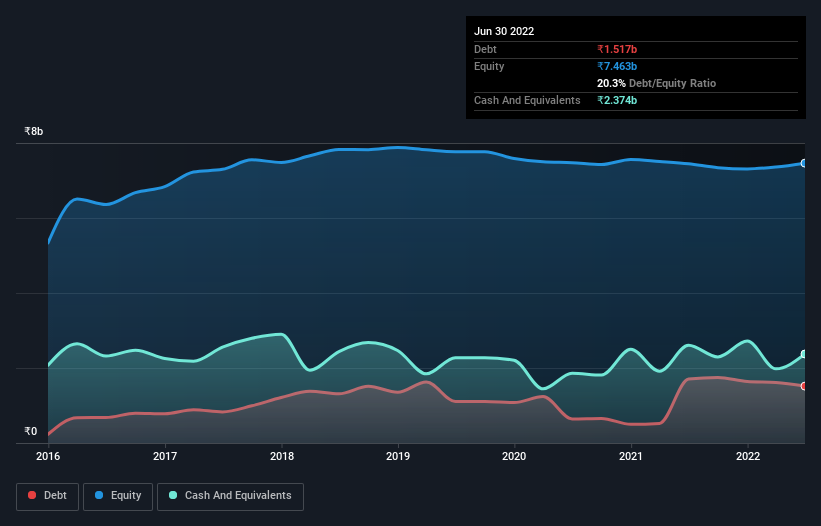- India
- /
- Real Estate
- /
- NSEI:ASHIANA
Health Check: How Prudently Does Ashiana Housing (NSE:ASHIANA) Use Debt?

David Iben put it well when he said, 'Volatility is not a risk we care about. What we care about is avoiding the permanent loss of capital.' When we think about how risky a company is, we always like to look at its use of debt, since debt overload can lead to ruin. Importantly, Ashiana Housing Limited (NSE:ASHIANA) does carry debt. But is this debt a concern to shareholders?
When Is Debt Dangerous?
Debt is a tool to help businesses grow, but if a business is incapable of paying off its lenders, then it exists at their mercy. Ultimately, if the company can't fulfill its legal obligations to repay debt, shareholders could walk away with nothing. However, a more usual (but still expensive) situation is where a company must dilute shareholders at a cheap share price simply to get debt under control. Of course, plenty of companies use debt to fund growth, without any negative consequences. The first thing to do when considering how much debt a business uses is to look at its cash and debt together.
Our analysis indicates that ASHIANA is potentially overvalued!
How Much Debt Does Ashiana Housing Carry?
You can click the graphic below for the historical numbers, but it shows that Ashiana Housing had ₹1.52b of debt in June 2022, down from ₹1.71b, one year before. However, it does have ₹2.37b in cash offsetting this, leading to net cash of ₹857.0m.

How Strong Is Ashiana Housing's Balance Sheet?
The latest balance sheet data shows that Ashiana Housing had liabilities of ₹9.79b due within a year, and liabilities of ₹2.08b falling due after that. Offsetting these obligations, it had cash of ₹2.37b as well as receivables valued at ₹253.9m due within 12 months. So it has liabilities totalling ₹9.24b more than its cash and near-term receivables, combined.
While this might seem like a lot, it is not so bad since Ashiana Housing has a market capitalization of ₹18.1b, and so it could probably strengthen its balance sheet by raising capital if it needed to. But we definitely want to keep our eyes open to indications that its debt is bringing too much risk. Despite its noteworthy liabilities, Ashiana Housing boasts net cash, so it's fair to say it does not have a heavy debt load! When analysing debt levels, the balance sheet is the obvious place to start. But you can't view debt in total isolation; since Ashiana Housing will need earnings to service that debt. So when considering debt, it's definitely worth looking at the earnings trend. Click here for an interactive snapshot.
Over 12 months, Ashiana Housing reported revenue of ₹2.5b, which is a gain of 6.5%, although it did not report any earnings before interest and tax. We usually like to see faster growth from unprofitable companies, but each to their own.
So How Risky Is Ashiana Housing?
Although Ashiana Housing had an earnings before interest and tax (EBIT) loss over the last twelve months, it made a statutory profit of ₹95m. So taking that on face value, and considering the cash, we don't think its very risky in the near term. Until we see some positive EBIT, we're a bit cautious of the stock, not least because of the rather modest revenue growth. The balance sheet is clearly the area to focus on when you are analysing debt. However, not all investment risk resides within the balance sheet - far from it. These risks can be hard to spot. Every company has them, and we've spotted 3 warning signs for Ashiana Housing (of which 2 are a bit unpleasant!) you should know about.
When all is said and done, sometimes its easier to focus on companies that don't even need debt. Readers can access a list of growth stocks with zero net debt 100% free, right now.
New: Manage All Your Stock Portfolios in One Place
We've created the ultimate portfolio companion for stock investors, and it's free.
• Connect an unlimited number of Portfolios and see your total in one currency
• Be alerted to new Warning Signs or Risks via email or mobile
• Track the Fair Value of your stocks
Have feedback on this article? Concerned about the content? Get in touch with us directly. Alternatively, email editorial-team (at) simplywallst.com.
This article by Simply Wall St is general in nature. We provide commentary based on historical data and analyst forecasts only using an unbiased methodology and our articles are not intended to be financial advice. It does not constitute a recommendation to buy or sell any stock, and does not take account of your objectives, or your financial situation. We aim to bring you long-term focused analysis driven by fundamental data. Note that our analysis may not factor in the latest price-sensitive company announcements or qualitative material. Simply Wall St has no position in any stocks mentioned.
About NSEI:ASHIANA
Ashiana Housing
Through its subsidiaries, engages in the real estate development business in India.
Excellent balance sheet average dividend payer.
Similar Companies
Market Insights
Community Narratives



